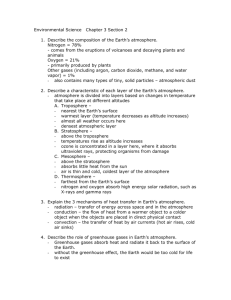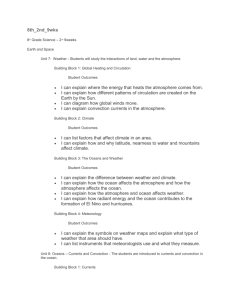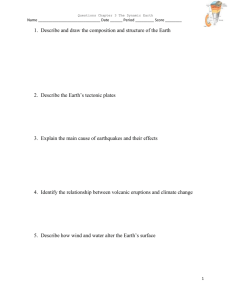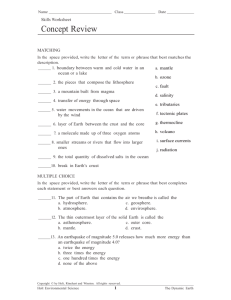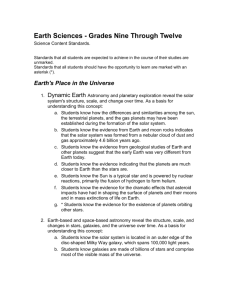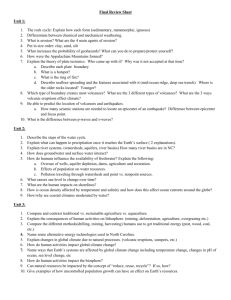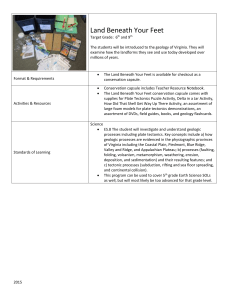Agricultural Earth Science Lab Manual
advertisement
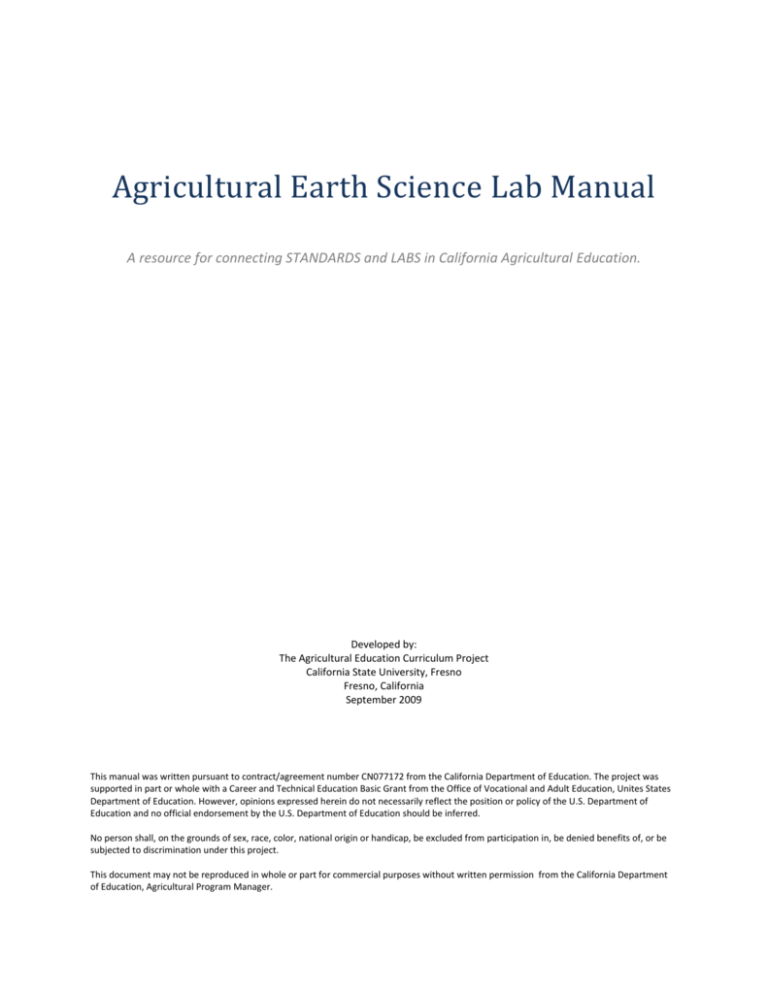
Agricultural Earth Science Lab Manual A resource for connecting STANDARDS and LABS in California Agricultural Education. Developed by: The Agricultural Education Curriculum Project California State University, Fresno Fresno, California September 2009 This manual was written pursuant to contract/agreement number CN077172 from the California Department of Education. The project was supported in part or whole with a Career and Technical Education Basic Grant from the Office of Vocational and Adult Education, Unites States Department of Education. However, opinions expressed herein do not necessarily reflect the position or policy of the U.S. Department of Education and no official endorsement by the U.S. Department of Education should be inferred. No person shall, on the grounds of sex, race, color, national origin or handicap, be excluded from participation in, be denied benefits of, or be subjected to discrimination under this project. This document may not be reproduced in whole or part for commercial purposes without written permission from the California Department of Education, Agricultural Program Manager. Agricultural Earth Science Lab Manual Major Concepts Earth’s place in the universe Dynamic earth processes Energy in the earth system Biogeochemical cycles Structure and composition of the atmosphere California Geology Resources Referenced Earth Sciences - Grades Nine through Twelve Science Content Standards www.cde.ca.gov/be/st/ss/scsearth.asp Agriculture Content Standards Grades 9-12 http://www.cde.ca.gov/ci/ct/sf/documents/ctestandards.pdf How to use this Manual A suggested year plan provides an outline to start planning your agricultural earth science class for the year. Online and text resources are provided to enhance your program. The agricultural earth science course has been broken into six major concepts, according to the Earth Sciences standards. Under each concept you will find the standards as well as several labs which can be used to help students master the standards. It is the intent of this manual to provide labs that require minimal resources and practical set up time, which support the goals of the agricultural education program. CONCEPT A: EARTH’S PLACE IN THE UNIVERSE Earth Sciences Standards 1. Astronomy and planetary exploration reveal the solar system's structure, scale, and change over time. As a basis for understanding this concept: a. Students know how the differences and similarities among the sun, the terrestrial planets, and the gas planets may have been established during the formation of the solar system. b. Students know the evidence from Earth and moon rocks indicates that the solar system was formed from a nebular cloud of dust and gas approximately 4.6 billion years ago. c. Students know the evidence from geological studies of Earth and other planets suggest that the early Earth was very different from Earth today. d. Students know the evidence indicating that the planets are much closer to Earth than the stars are. e. Students know the Sun is a typical star and is powered by nuclear reactions, primarily the fusion of hydrogen to form helium. f. Students know the evidence for the dramatic effects that asteroid impacts have had in shaping the surface of planets and their moons and in mass extinctions of life on Earth. g. * Students know the evidence for the existence of planets orbiting other stars. 2. Earth-based and space-based astronomy reveal the structure, scale, and changes in stars, galaxies, and the universe over time. As a basis for understanding this concept: a. Students know the solar system is located in an outer edge of the disc-shaped Milky Way galaxy, which spans 100,000 light years. b. Students know galaxies are made of billions of stars and comprise most of the visible mass of the universe. c. Students know the evidence indicating that all elements with an atomic number greater than that of lithium have been formed by nuclear fusion in stars. d. Students know that stars differ in their life cycles and that visual, radio, and X-ray telescopes may be used to collect data that reveal those differences. e. * Students know accelerators boost subatomic particles to energy levels that simulate conditions in the stars and in the early history of the universe before stars formed. f. * Students know the evidence indicating that the color, brightness, and evolution of a star are determined by a balance between gravitational collapse and nuclear fusion. g. * Students know how the red-shift from distant galaxies and the cosmic background radiation provide evidence for the "big bang" model that suggests that the universe has been expanding for 10 to 20 billion years. Lab Reference: Earth’s Place in the Universe Standards: 1a-g, 2a-g STANDARD CONCEPT Astronomy Astronomy Astronomy Elements/Minerals Elements/Minerals LAB NAME Astronomy Book The Big Bang Balloon The Life Cycle of Stars: Webquest Effects of Minerals on Plant Growth Element Project: Class Periodic Table LAB NUMBER A-1 A-2 A-3 A-4 A-5 CONCEPT B: DYNAMIC EARTH PROCESSES Earth Sciences Standards 3. Plate tectonics operating over geologic time has changed the patterns of land, sea, and mountains on Earth's surface. As the basis for understanding this concept: a. Students know features of the ocean floor (magnetic patterns, age, and sea-floor topography) provide evidence of plate tectonics. b. Students know the principal structures that form at the three different kinds of plate boundaries. c. Students know how to explain the properties of rocks based on the physical and chemical conditions in which they formed, including plate tectonic processes. d. Students know why and how earthquakes occur and the scales used to measure their intensity and magnitude. e. Students know there are two kinds of volcanoes: one kind with violent eruptions producing steep slopes and the other kind with voluminous lava flows producing gentle slopes. f. * Students know the explanation for the location and properties of volcanoes that are due to hot spots and the explanation for those that are due to subduction. Lab Reference: Dynamic Earth Processes Standards: 3a-f STANDARD CONCEPT Earthquakes Ocean Floor Ocean Floor Plate Tectonics Plate Tectonics Plate Tectonics Properties of Rock Properties of Rock Properties of Rock Volcanoes Volcanoes Volcanoes LAB NAME Virtual Earthquake Webquest Sea Floor Spread The Ocean Floor and Particle Size Plate Boundaries Plate Tectonics Webquest Snack Tectonics Classifying Rocks Density of Solids—How Sweet it is! Density: Solids vs. Liquids Creating a Simulation Volcano Effects of Magma on Surrounding Rock Volcanoes—Problem Based Learning LAB NUMBER B-1 B-2 B-3 B-4 B-5 B-6 B-7 B-8 B-9 B-10 B-11 B-12 Earth Sciences Standards CONCEPT C: ENERGY IN THE EARTH SYSTEM 4. Energy enters the Earth system primarily as solar radiation and eventually escapes as heat. As a basis for understanding this concept: a. Students know the relative amount of incoming solar energy compared with Earth's internal energy and the energy used by society. b. Students know the fate of incoming solar radiation in terms of reflection, absorption, and photosynthesis. c. Students know the different atmospheric gases that absorb the Earth's thermal radiation and the mechanism and significance of the greenhouse effect. d. * Students know the differing greenhouse conditions on Earth, Mars, and Venus; the origins of those conditions; and the climatic consequences of each. 5. Heating of Earth's surface and atmosphere by the sun drives convection within the atmosphere and oceans, producing winds and ocean currents. As a basis for understanding this concept: a. Students know how differential heating of Earth results in circulation patterns in the atmosphere and oceans that globally distribute the heat. b. Students know the relationship between the rotation of Earth and the circular motions of ocean currents and air in pressure centers. c. Students know the origin and effects of temperature inversions. d. Students know properties of ocean water, such as temperature and salinity, can be used to explain the layered structure of the oceans, the generation of horizontal and vertical ocean currents, and the geographic distribution of marine organisms. e. Students know rain forests and deserts on Earth are distributed in bands at specific latitudes. f. * Students know the interaction of wind patterns, ocean currents, and mountain ranges results in the global pattern of latitudinal bands of rain forests and deserts. g. * Students know features of the ENSO (El Niño southern oscillation) cycle in terms of sea-surface and air temperature variations across the Pacific and some climatic results of this cycle. 6. Climate is the long-term average of a region's weather and depends on many factors. As a basis for understanding this concept: a. Students know weather (in the short run) and climate (in the long run) involve the transfer of energy into and out of the atmosphere. b. Students know the effects on climate of latitude, elevation, topography, and proximity to large bodies of water and cold or warm ocean currents. c. Students know how Earth's climate has changed over time, corresponding to changes in Earth's geography, atmospheric composition, and other factors, such as solar radiation and plate movement. d. * Students know how computer models are used to predict the effects of the increase in greenhouse gases on climate for the planet as a whole and for specific regions. Lab Reference: Energy in the Earth System Standards: 4a-d, 5a-g, 6a-d STANDARD CONCEPT Climate and Weather Climate and Weather Climate and Weather Earth Greenhouse Effect Ocean Currents Ocean Currents Ocean Currents Salinity Solar Energy Wind Patterns LAB NAME Caleb Weatherbee: Farmer’s Almanac Creating a Climatogram Jack Frost and The Crops: Farmer’s Almanac Half Earth Model: Winds, Currents and Climate Modeling The Greenhouse Effect Graphing Tidal Cycles Ocean Circulation Webquest Ocean Currents and Climate Salinity Insulation: Preventing Conduction Wave Motion LAB NUMBER C-1 C-2 C-3 C-4 C-5 C-6 C-7 C-8 C-9 C-10 C-11 CONCEPT D: BIOGEOCHEMICAL CYCLES Earth Sciences Standards 7. Each element on Earth moves among reservoirs, which exist in the solid earth, in oceans, in the atmosphere, and within and among organisms as part of biogeochemical cycles. As a basis for understanding this concept a. Students know the carbon cycle of photosynthesis and respiration and the nitrogen cycle. b. Students know the global carbon cycle: the different physical and chemical forms of carbon in the atmosphere, oceans, biomass, fossil fuels, and the movement of carbon among these reservoirs. c. Students know the movement of matter among reservoirs is driven by Earth's internal and external sources of energy. d. * Students know the relative residence times and flow characteristics of carbon in and out of its different reservoirs. Lab Reference: Biogeochemical Cycles Standards: 7a-d STANDARD CONCEPT Carbon Cycle Element Cycles Nitrogen Cycle Rock Cycle Soils Soils Water Water Cycle Weathering Weathering Weathering LAB NAME Dinosaur Breath Hyperlink Habitats Farming Nitrogen Modeling the Rock Cycle Elementary Study of Soils Soil Permeability Water Conservation The Water Cycle and The Environment Causes of Weathering Effect of Temperature on Chemical Weathering Weathering and Erosion Picture LAB NUMBER D-1 D-2 D-3 D-4 D-5 D-6 D-7 D-8 D-9 D-10 D-11 CONCEPT E: STRUCTURE & COMPOSITION OF THE ATMOSPHERE Earth Sciences Standards 8. Life has changed Earth's atmosphere, and changes in the atmosphere affect conditions for life. As a basis for understanding this concept: a. Students know the thermal structure and chemical composition of the atmosphere. b. Students know how the composition of Earth's atmosphere has evolved over geologic time and know the effect of outgassing, the variations of carbon dioxide concentration, and the origin of atmospheric oxygen. c. Students know the location of the ozone layer in the upper atmosphere, its role in absorbing ultraviolet radiation, and the way in which this layer varies both naturally and in response to human activities Lab Reference: Structure & Composition of the Atmosphere Standards: 8a-c STANDARD CONCEPT Atmosphere Atmosphere Ozone LAB NAME Air Quality: Changing The Percentage of Oxygen The Effect of Humans on the Atmosphere Ozone Detection LAB NUMBER E-1 E-2 E-3 CONCEPT F: CALIFORNIA GEOLOGY Earth Sciences Standards 9. The geology of California underlies the state's wealth of natural resources as well as its natural hazards. As a basis for understanding this concept: a. Students know the resources of major economic importance in California and their relation to California's geology. b. Students know the principal natural hazards in different California regions and the geologic basis of those hazards. c. Students know the importance of water to society, the origins of California’s fresh water, and the relationship between supply and need. d. * Students know how to analyze published geologic hazard maps of California and know how to use the map's information to identify evidence of geologic events of the past and predict geologic changes in the future. Lab Reference: California Geology Standards: 9a-d STANDARD CONCEPT California Geology California Geology Natural Hazards Natural Hazards Natural Hazards Water Water Water LAB NAME Element Project Modeling Earth’s Farmland California Agriculture Production Map California Natural Hazards-Picture Book Project Making Earthquake-safe Buildings Managing Water Through Slope and Velocity Raindrop Erosion What Are Their Water Needs LAB NUMBER F-1 F-2 F-3 F-4 F-5 F-6 F-7 F-8 Contributing Teachers This compilation of labs has been produced under a special grant through California State University, Fresno Agricultural Education under the direction of Dr. Rosco Vaughn. Labs were submitted by agriculture teachers throughout California. The sacrifice made by teachers who took the time to share labs they have acquired and/or developed is greatly appreciated and integral in continuing to improve agricultural education in California. Thank you to the following individuals for contributions to this project: Aaron Albisu, Spring Creek High School, Spring Creek, NV Amber Madlem & Science Staff at Central Valley High School, Ceres Amy Schulte, Davis High School Atwater High School Agriculture Department Brian Combes, Hanford High School Christine Dickson, North High School, Bakersfield Claire Gebers, Merced High School Daniel Galan, Calexico High School Diane Prescott, Atwater High School Elizabeth Knapp, Atwater High School Heather Opfergelt, Firebaugh High School Izaskun Zallo, Pleasant Grove High School, Elk Grove Jamie Sakugawa, Mt. San Antonio College JessaLee Goehring, Lodi High School Jill Sperling, Kingsburg High School Jim Looper, Sheldon High School John Kohntopp, Elko High School, Elko, NV Katy Parson, Golden Valley High School, Bakersfield Krista Vannest, John H. Pitman High School, Turlock Kristen Machado, East Union High School, Manteca Laura Mendes, St. Helena High School Lorilee Niesen, Maxwell High School Markie Severtson, Calexico High School Mandi Bottoms, California Agriculture In The Classroom Maria Rangel, Holtville High School Ron Sa, Reedley High School Steven Rocca, California State University, Fresno Susan Young, Sutter High School Theresa Noga, Arcata High School Other Contributing Agricultural Educators Formatting and Compilation: A. Mayfield Curriculum Development http://amayfieldcurriculum.vpweb.com/ Review and Documentation of Standards: Karen Dalton-Wemp Labs Submitted by California Polytechnic State University, San Luis Obispo Students: Dr. Wendy Warner Editing and Formatting: Dr. Steven Rocca Project Director: Dr. Rosco Vaughn

